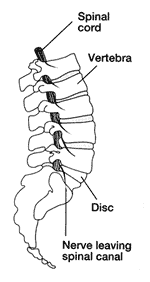About the Back and Back Problems
The human spine (or backbone) is made up of small bones called vertebrae. The vertebrae are stacked on top of each other to form a column. Between each vertebra is a cushion known as a disc. The vertebrae are held together by ligaments, and muscles are attached to the vertebrae by bands of tissue called tendons.
Openings in each vertebra line up to form a long hollow canal. The spinal cord runs through this canal from the base of the brain. Nerves from the spinal cord branch out and leave the spine through the spaces between the vertebrae.
The lower part of the back holds most of the body's weight. Even a minor problem with the bones, muscles, ligaments, or tendons in this area can cause pain when a person stands, bends, or moves around. Less often, a problem with a disc can pinch or irritate a nerve from the spinal cord, causing pain that runs down the leg, below the knee, called sciatica.
| Muscles of the Back and Spine |
 |
 |
Proceed to Next Section

